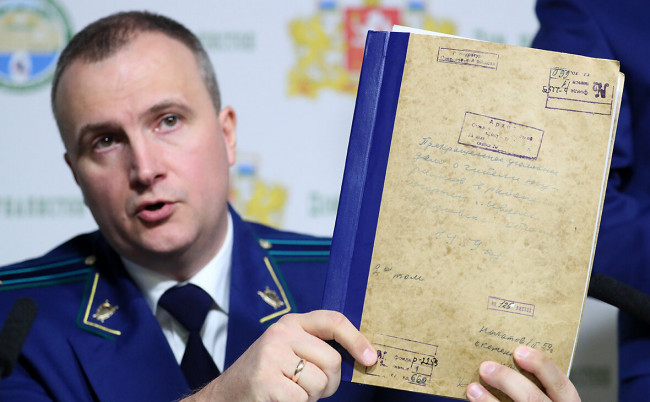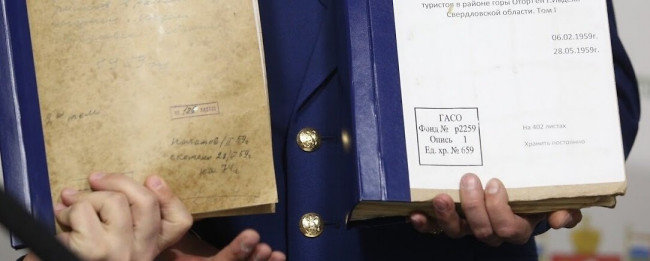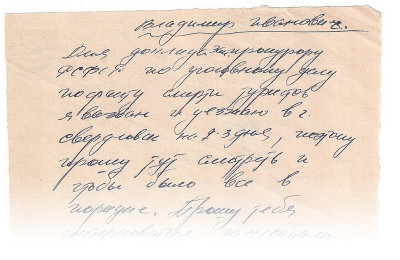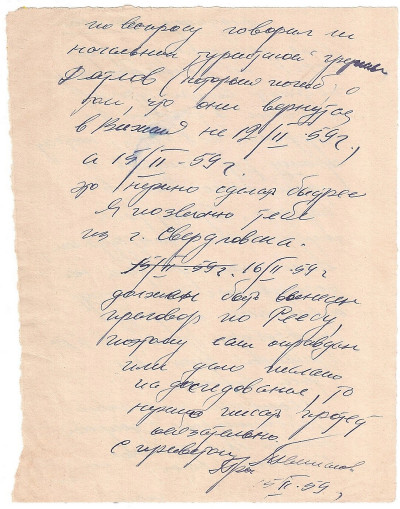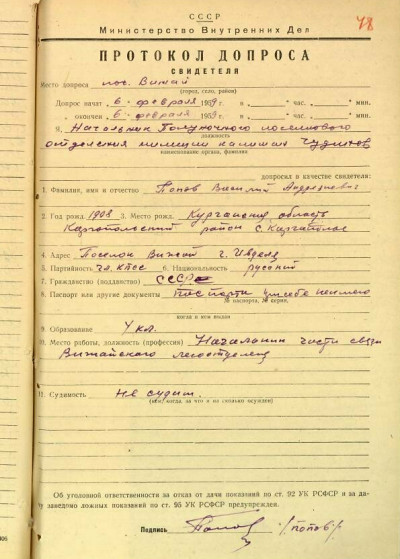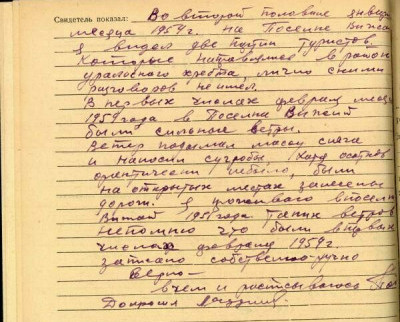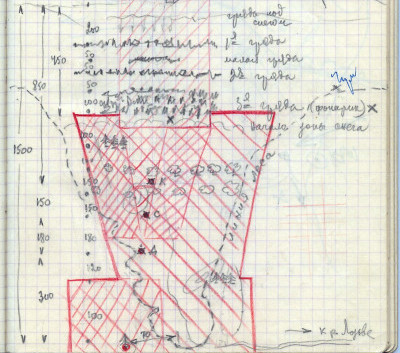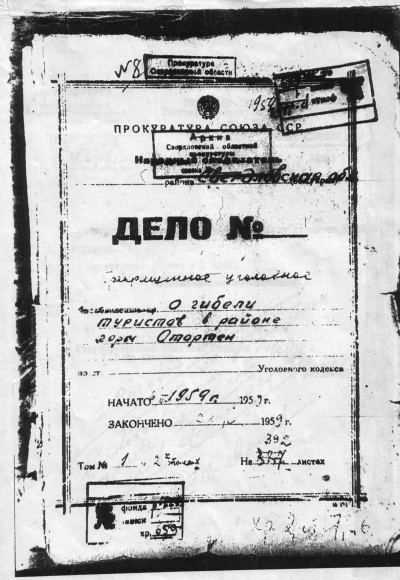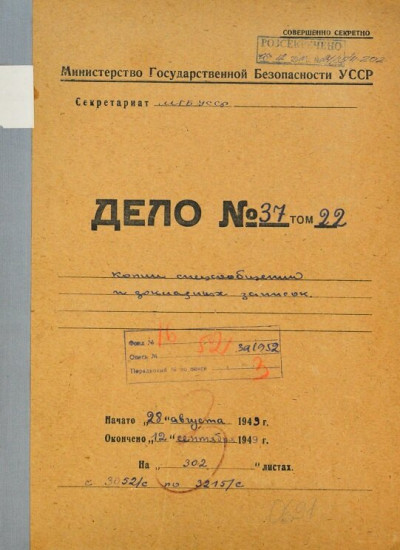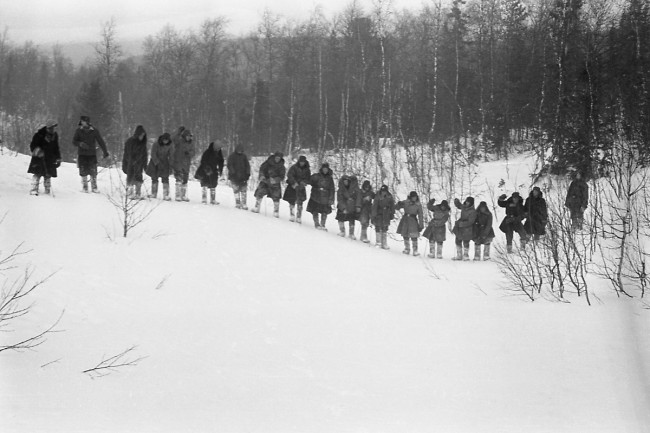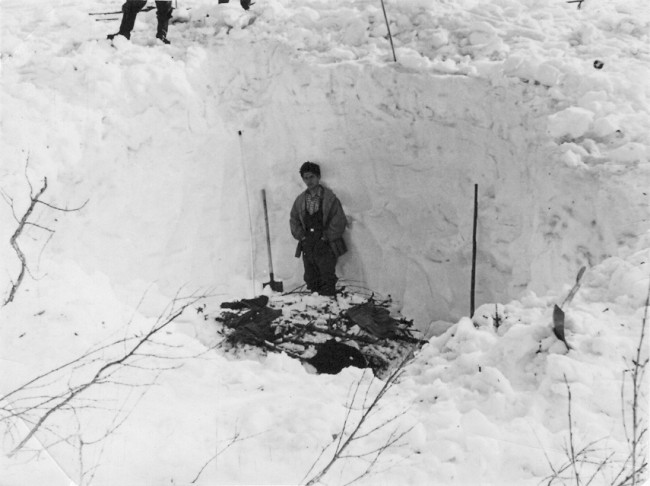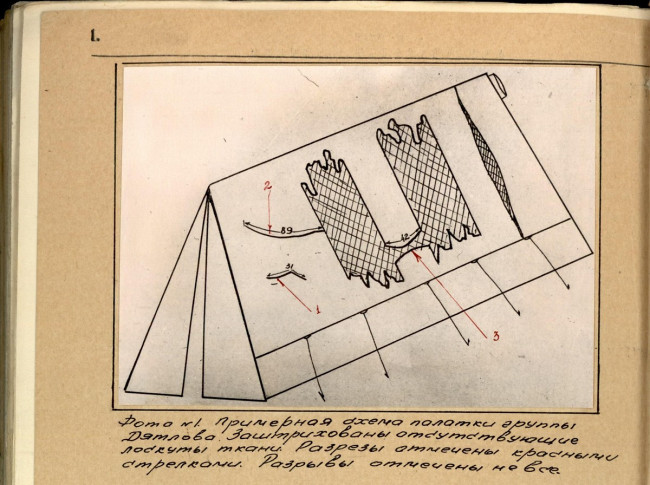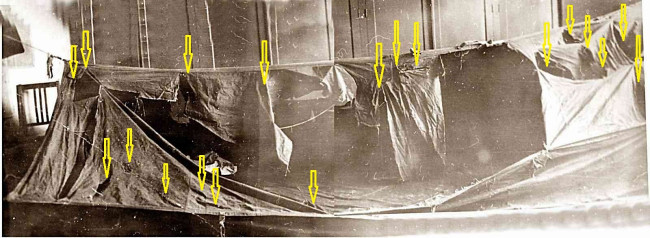
Dyatlov Pass - the latest version. A trap for the prosecutor.
Author Igor Povetkin
Fool me once, shame on you; fool me twice, shame on me
In February 1959, nine people died at the Dyatlov pass. Dozens of versions have been put forward on this topic. You will read about the reprisal of the ferocious Mansi, and aliens, coupled with American saboteurs. They will present you with fugitive convicts, avalanches and carbon monoxide poisoning. They are versions where hikers quarreled among themselves and the intrigues of the Yeti, atomic bombs and treasures of gold, etc., etc., etc.
Versions are pouring out of a cornucopia. The overwhelming majority of them are born of the author's fantasy and imagination, some are inspired by delirium, others - by their authors' penchant for exoticism and exaggeration, but these versions have one common feature.
All of them are far-fetched, while the real, working version should be based not on notions and stupidity, but on the totality of not invented, but established circumstances that no one doubts and which, if properly analyzed, are difficult to ignore or refute. It is this version that will be the closest to the truth. The ability to notice and compare disparate facts and details is a great thing. Any analyst will confirm this to you.
§1 Open the book - there is a middle finger
I will not repeat the known. I will only mention that, presumably, on the night of February 2, 1959, in the Ivdel district of the Sverdlovsk region, near the height of 1079 (later called Mount Kholatchakhl), a group of nine hikers led by Igor Dyatlov died under mysterious circumstances.
The dead are Igor Dyatlov himself, as well as Yuri Doroshenko, Lyudmila Dubinina, Semyon Zolotaryov, Aleksander Kolevatov, Zinaida Kolmogorova, Georgiy Krivonischenko, Rustem Slobodin and Nikolay Thibeaux-Brignolle.
The deaths of L. Dubinina, S. Zolotaryov and N. Thibeaux-Brignolle came from bodily injuries received pre mortem, the others from hypothermia or exposure from cold. Before their death, the hikers, for some unknown reason, at night in a severe frost, undressed and took off their shoes, left the tent, after which the whole group soon died.
The first searchers found the tent on February 25 or 26, 1959.
On February 26, the first bodies of Y. Doroshenko, G. Krivonischenko, I. Dyatlov, Z. Kolmogorova and R. Slobodin were found, and on May 4, the remaining four bodies of L. Dubinina, N. Thibeaux-Brignolle, S. Zolotaryov and A. Kolevatov...
We will not surprise the reader with guesses about the circumstances of what happened at the camp site on February 1 and 2. We will look at the situation from a different angle. Namely, let us consider how a criminal case was initiated into the death of I. Dyatlov and his comrades. We will see a lot of interesting and incomprehensible details. All documents mentioned here are in the public domain on the Internet.
The decision to initiate a criminal case was issued by V. Tempalov, the prosecutor of the city of Ivdel.
This resolution was issued on February 26, 1959 and it states that the case was initiated "in connection with the data on the discovery of the corpses of student hikers at the height 1079". So it is written in the introductory part of the resolution.
Here is what says in the main part.
"At an altitude of 1079, the frozen bodies of Krivonischenko, Z. Kolmogorova, Dyatlov and other student-hikers of the Sverdlovsk Polytechnic Institute (as in the text) were found and, taking into account that this fact requires a preliminary investigation ..." and so on.
This document would be nothing if not for the date - February 26. The number "two" looks clearly alien and falls out of the general picture and is discordant with the style and rhythm of what was written. It seems that the decree was passed not on the twenty-sixth, but on the sixth of February, and the "two", correcting himself, was added later, after the rescuers arrived at the scene of the tragedy and the first bodies were found. And this, by the way, is an official forgery.
– 2 –
On the cover of the first volume of the case files on the death of hikers in the area of Mount Otorten it is clearly written that it was opened on 6 II (Roman "two") 1959. If this is not enough, then the same date is indicated on the cover of the second volume - 6 II (Roman "two") 1959.
On the Internet, you can easily find a photo of 2019, where the prosecutor demonstrates to journalists the case files about the death of the Dyatlov group, on the cover of which the date is clearly visible - 6/II 1959.
We know that reaching the final point of the route, the village of Vizhay, was planned on on February 12, and that Dyatlov was supposed to send a telegram to the Ural Polytechnic University Sports club.
Despite this, on February 6, the prosecutor of Ivdel, Junior Counselor of Justice Vasiliy Ivanovich Tempalov, knew for sure that all members of the Dyatlov group were already dead by this time.
His awareness is evidenced not only on the cover of the criminal case. On February 15, 1959 V. Tempalov wrote a memo to his deputy Korotaev:
"To report to the Deputy Prosecutor of the RSFSR on the criminal case on the death of the hikers, I am leaving for Sverdlovsk for 2-3 days."And more. "In addition, on the instructions of the regional prosecutor to interrogate the chief of the logging branch of Vizhay Hakimov whether the leader of the hikers group (who died) said that they will return to Vizhay not on 12.II. 59 but 15.II.59. This needs to be done fast."
We repeat that this note is dated by Tempalov on February 15, 1959. This means that as early as February 6, law enforcement agencies knew about the death of the Dyatlov group, the place of death was known, and on the fact of the death of the hikers on that day, a criminal case was opened, immediately taken under control by the RSFSR prosecutor's office, whose representative was already in Sverdlovsk and demanded a report on the progress of the investigation.
And all this despite the fact that the relatives of the victims began to sound the alarm on February 16 or 17, and the first bodies were found only on February 26.
In a note to Korotaev, Tempalov mentions a case on the charge of a certain Reeba, which is to be heard in court on 16.02.59. The prosecutors explained that Reeba's case was actually considered by the court on April 16, 1959 and, therefore, Tempalov, indicating the date - February 16 - was mistaken. And he dated his note to February 15 by mistake as well.
This explanation cannot be accepted.
Let's not argue, perhaps, Reeba's case was finally considered by the Ivdel City Court on April 16, 1959. But we do not know, and the prosecutors kept silent about this, whether Reeba's case was returned for further investigation and whether Reeba was acquitted on February 16. Tempalov in the memo admits the possibility of both, and Korotaev should not be held responsible in this situation.
And without this, we believe not the prosecutor's assurances, but what we see - 02/15/1959.
– 3 –
On February 6, 1959, a criminal case was not only opened, but investigative actions were already carried out on the same day. Let's turn to the case files.
In the first volume on page 48 there is a record of the interrogation of the witness V.A. Popov. He was interrogated by the head of the Polunochnoe settlement police station, Captain Chudinov.
The witness testified that in the second half of January he saw hikers in the village of Vizhay heading for the Ural ridge region, and that in the first days of February very strong winds were blowing in the village, such as he has never seen before.
The date indicated in the protocol of Popov's interrogation is February 6, 1959 hence the date on the cover criminal case - February 26 - is fictitious.
Why did this document remain in the file? Probably due to the carelessness of those who "cleaned up" this case. Thanks to their negligence, some circumstances in the case of the death of the hikers, in particular, the date of its initiation, we know for sure today - February 6, 1959.
There is more to think about.
This is file 77 in volume one - a drawing of the scene. She, along with other diagrams, drawings and plans, is sewn between the protocols of interrogation of witnesses dated March 10, 1959.
This drawing is remarkable because it has the locations of all nine bodies of the dead hikers, although we all know that the last four bodies in the creek were discovered only on May 6, 1959 (Case file 341), i.e. almost two months later.
Or here's a diagram on a case sheet without a number, sewn between case sheets 77 and 79.
There is a title on top "Scheme of measurements of the accident site (the ravine of the Lozva river stream)".
The question naturally arises: what did the person who made this scheme mean by the word "accident"? Was this an involuntary slip of the tongue about awareness of the technogenic nature of what happened, or just a figure of speech?
However, be that as it may, the word "accident" is present in the criminal case already at the initial stage of its investigation.
– 4 –
§2 Missing number
The date of the initiation of the criminal case is not the only circumstance that our home-grown "Pinkertons" did not pay attention to.
The criminal case on the death of the Dyatlov group is fundamentally different from all other criminal cases.
It does not have a registration number.
This is highly unusual. It's like the head of the traffic police who doesn't have a personal car. Or a person without a passport. Or a wedding without a fight.
I'm not even talking about the rules of office work, about all these orders, instructions, registration books, statistical cards, information centers ...
Even the first Soviet movie detective (1956) has a number: "Case №306".
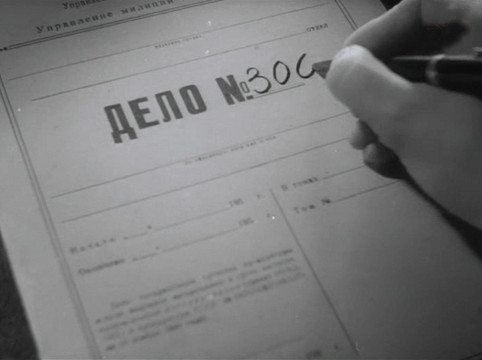
But the case of the death of Igor Dyatlov and his comrades has no number.
Such a number is indicated immediately after receiving it with a pen or pencil on the decision to initiate a criminal case. Usually this is done either by the investigator himself or by the head of the office.
Then, the number appears on the cover of the criminal case. It is printed in large print "CRIMINAL CASE №______". From this point on the investigator puts on all the documents he creates the classic stamp "Investigator of the ... Prosecutor's Office, a lawyer of the Class II L.N. Ivanov, having examined the materials of criminal case №______ on the fact of such and such or on charges of such and such a - that the articles of the Criminal Code of the RSFSR, established..."
Well, so, in the materials on the death of the Dyatlov group at an altitude of 1079, you will not find the numbers of the criminal case. It is really missing. The number of the case is not indicated even in the decision to terminate this very case.
What case was investigated and terminated on May 28, 1959 by the prosecutor-criminalist of the Sverdlovsk Regional Prosecutor's Office, who was conducting the investigation, Junior Counselor of Justice Lev Nikitich Ivanov?
The criminal case has no number - it's not a trifle, not a child's play. For those who are unaware: in criminal proceedings, there has been and still is a system of statistical cards filled in by the investigator and sent to the information center of the department of internal affairs of a region.
Statistical cards are put up for a new case, for a person detained on suspicion, for bringing charges, for transferring a case under investigation, for extending the investigation period, for completing an investigation, for dismissing a case, as well as in some other cases. The issue of cards is a mandatory procedure and each of them indicates the number of the criminal case, without which the entire statistical accounting system loses its meaning.
The lack of a number is a serious matter. Moreover, the case in question is being investigated not by a half-drunk investigator or an ordinary investigator, but by a criminal prosecutor of the regional prosecutor's office. Criminal prosecutors are the elite of the prosecutor's investigation. The cream of the crop.
– 5 –
And the matter itself is not simple, and therefore it was taken under control from the very beginning in the RSFSR prosecutor's office at the level of the republic's prosecutor.
The foregoing allows us to state: the criminal case about the death of the Dyatlov group, with such close attention to him, does not have a registration number.
And at the same time to think: but why isn't there a number?
In 2019, prosecutors publicly admitted at a press conference that the Dyatlov case had no registration number(!). Recognizing this odious fact, they tried to explain the absence of a number by the fact that at that time the cases that did not reach the court were not numbered.
This is bullshit. The number is assigned to the case at the stage of initiation, and not at the stage of completion of the preliminary investigation and sending the criminal case to the court. You can read about this in the Regulation on the unified registration of crimes. When making such ridiculous statements about the peculiarities of registration of criminal cases, the prosecutor did not need to use expressions like "probably" and "apparently". Name specific paragraphs, articles or points of a specific normative act and do not tread us like fools!
The prosecutors, it seems, to this day, consider the public a bunch of idiots. Only we are not idiots.
The weirdness doesn't end there. The criminal case is missing not only the registration number, but also the reason for its initiation. What is the reason? In this case, this is any official information about the death of the hikers, on the basis of which a decision to initiate a case was issued on February 6. It could be a radiogram of geologists or hikers who stumbled upon an abandoned tent, a report from a district commissioner who received a message about the discovery of dead bodies, a report from the head of a military patrol sent to the area of the alleged fall of fragments of missiles launched the day before, a statement from a local hunter, that is, any piece of paper containing information sufficient to initiate a case. Such documents are usually filed on the second page of the first volume of the criminal case. But not in this case. On the second sheet in our file, we see the protocol of the inspection of the scene of the incident dated February 28, 1959.
On the document with the reason for the initiation of the case, there must be a stamp from the office of the prosecutor's office with the date of receipt and the registration number under which this document is registered in the logs of incoming correspondence.
A memo may be attached to it, and on it, as well as written directly on the document, there may be directives and guiding resolutions of higher officials...
So where is the reason? No reason. And it must be in accordance with Article 96 of the then Criminal Procedure Code of the RSFSR.
So in the decision to initiate a criminal case on February 6, 1959, prosecutor Tempalov wrote that "having familiarized himself with the data on the discovery of the dead bodies of student hikers at an altitude of 1079" ...
Take a look at the same data on the discovery of bodies.
And another nuance. A criminal case is initiated only if there are signs of some kind of foul play, murder, negligence, treason, etc., provided for by a specific article of the Criminal Code.
However, the decision to initiate a case on the death of the hikers does not contain an indication of either the signs of a crime or the article number of the criminal law under which this case was initiated.
This should not be the case in principle. But it is so.
In passing, we note that the criminal case on the death of the Dyatlov group does not have a Classified stamp, although it is known that at some stage of the investigation it was classified. In this case, the cover of the case should have been classified as "secret", "top secret", or "of special importance."
This is how the case should have looked if the Proceedings Instruction were followed.
Here is everything that is supposed to be when the rules are followed: the case number, the Classified stamp and the stamp on the declassification of the case.
However, in our case, for some reason, the Classified stamp is absent, so is the decree on declassifying the materials of the criminal case. I wonder why?
Maybe the public is not presented with the case itself for comfort, but its doctored copy or dummy?
– 6 –
§3 The higher echelon
The appearance, quality of registration and content of the criminal case on the death of the Dyatlov group are all the more surprising if you know who supervised the course of its investigation.
Having written about the control over the Dyatlov case by the republican prosecutor's office, I made a mistake and incorrectly determined the level of this control. I underestimated it. In fact, everything was much more serious.
To monitor the progress of the investigation, a state commission was created, which included:
M.N. Shishkarev Major General of the Ministry of Internal Affairs
V.A. Pavlov Deputy Chairman of the Sverdlovsk Regional Executive Committee
F.T. Ermash Head of the department of the Sverdlovsk Regional Committee of the CPSU
N.I. Klinov Prosecutor of the Sverdlovsk Region, and
M.I. Gorlachenko 1st Deputy Commander of the Air Force of the Ural Military District, Major General of Aviation
Commander of the Ural Military District Colonel-General D.D. Lelyushenko personally (I repeat - PERSONALLY!) inspected the progress of the search operation on the spot, and the regional prosecutor N.I. Klinov was present in the hospital morgue of the Ivdel correctional labor colony during the autopsies of the dead and together with the forensic physician B.A. Vozrozhdenniy signed the medical reports with the forensic results.
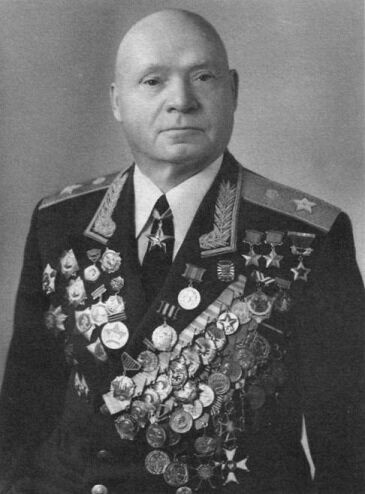
General of the Army D.D. Lelyushenko
When an investigator works on the scene, this is natural. No one will be surprised if they see an investigator in a morgue during an autopsy on a case in progress. This is his job.
As for his boss, the city or district prosecutor, in Soviet times he was ordered to personally travel to crime scenes only in criminal cases of premeditated murder. But the prosecutors did not go to the autopsies in the prison morgues.
Likewise, the commanders of military districts did not visit the multi-star generals of the places of death of civilians not related to the military department or military service. What for?
But in the Dyatlov group case, the military was tight-lipped on the situation. Not the guards from the nearby labor camps, but the military. The army not only controlled the search and investigation, it actively helped in the execution, providing the necessary number of personnel to conduct searches on the spot, transport, including air, communications, supplies and everything that was needed.
Colonel-General D. D. Lelyushenko came to the height of 1079 for a reason. He visited the site of the tragedy in order to report on what he saw to higher authorities.
What were these instances?
General staff? Ministry of Defense?
It's possible.
But if we take into account the presence of high-ranking Soviet and party leaders in the state commission, the commander of the Ural Military District had to report the situation not to his ministry, more precisely, not only to him. Most likely, a report was expected from him in the supreme governing and directing body of the country - in the Central Committee of the Communist Party of the Soviet Union.
The final document of the same state commission should have gone there too..
What was it, if it was: act, conclusion, memorandum, report, memo?
We don't have a way of knowing this, and we won't guess, but just a remark that it would be very helpful to be able to glance at the report of Colonel-General D.D. Lelyushenko.
§4 The soldiers
The State Commission controls the investigation into the circumstances of the death of the hikers at an altitude of 1079, and its activities are supervised by the commander of the Ural Military District.
He's in charge. It controls a vast territory from several regions and autonomous regions and has practically unlimited administrative and material resources.
His person was included in the commission for a reason.
Major General Mihail Yosifovich Gorlachenko is in his place. He is the first deputy commander of the district's air force. He also commands the anti-aircraft missile forces, then part of the air force.
– 7 –

Major General M.I. Gorlachenko
He is aware that American reconnaissance aircraft - high-altitude balloons and U-2 reconnaissance aircraft, inaccessible to Soviet anti-aircraft missiles - operate with impunity in the airspace of the USSR.
General Gorlachenko knows that the S-75 Dvina anti-aircraft missile system (range 22 km) is being urgently modified and is currently being actively tested in the Desna variant (range up to 34 km).
Together with the S-75 Desna air defense missile system, other missile systems are also being tested, the flights and crashes of which, as well as their fragments, fall on the areas in one of which the hikers from the Dyatlov group died. Local residents saw luminous UFOs and fragments of missiles were found on the ground.

Anti-aircraft missile system S-75 Desna
The situation is complex and is associated with top-secret strategic defense issues.
It is for this reason that the military tightly controled the course of the investigation and General Gorlachenko was introduced to the state commission. He was assisted by the operational forces of the Ministry of Internal Affairs and the party-Soviet bodies on the ground.
The military knew that on the night of February 2, 1959, in the area of altitude 1079, the Dyatlov group accidentally collided with the servicemen who were there in connection with missile tests and the fall of missile fragments, blocks or stages to the ground, and that this meeting was fatal for the hikers.
And if the criminal case was really opened already on February 6, then generals Lelyushenko and Gorlachenko had information about the death of the Dyatlov group earlier, having received it, probably, first hand immediately after the tragedy.
And only an eyewitness could report the death of the hikers in the first days of February.
Based on the foregoing, it is possible to assume that two parties participated in the events on the Dyatlov pass, one of which could be the servicemen of the Soviet army.
There are no other reasons for participating in the investigation of the case of high-ranking generals.
I'm not saying that the military killed the Dyatlov group, but they controlled the investigation of the criminal case. And, if at first civilians were engaged in the search for the dead,
then later all of them were replaced by military personnel.
– 8 –
"So what?" - the inquisitive reader will ask. - "Who needed all this? How did it end?"
Well, we have something to be proud of. Already in May 1959, that is, immediately after the termination of the criminal case, Colonel General Lelyushenko was promoted to army general. It would be possible to admit the assignment of such a high rank to commemorate Victory Day, but there was no such holiday in the USSR in 1959. Whether this increase is due to his participation in a politically correct investigation of the death of the Dyatlov group, I do not know, but the fact remains.
A year later, the Americans no longer flew in our Soviet sky, Eisenhower was forced to publicly admit the involvement of the White House in espionage in the USSR, and then we exchanged the pilot Francis Powers who was shot down over Sverdlovsk (what a coincidence, who would have thought - over Sverdlovsk!) our illegal scout Rudolf Abel.
§5 Let's get to the point
Firstly, the criminal case gives the impression of a cello made with an ax and nails. Given the level of control that was exercised over the investigation, this circumstance looks more than strange.
Secondly, from reading the case, a persistent feeling remained that on the slope of height 1079 at the time of the tragedy, the hikers were not alone, that there were other strangers, who were not part of the group, almost invisible and not named, but that however, they are definitely real.
These unknown eyewitnesses or even participants, reported what had happened on command, and it was from them that the Prosecutor Tempalov already knew on February 6 that a tragedy had occurred in the area of height 1079, that the bodies of the hikers who died from freezing were found there, that is, he knew the cause of their death, and rightly believed that a preliminary investigation was required on this fact.
When initiating a criminal case on February 6, Tempalov was aware of the fact of the tragedy, its place and consequences. It goes without saying that all this information was not brought to the prosecutor by a birdie.
Such information in early February to the prosecutor, and not only to him, could only be reported by an eyewitness who was at the scene, who directly observed the tragedy and knew in detail its details and outcome.
If this is so, then we have the right to suspect the prosecutor and others with power that be, in particular, members of the state commission, who controlled the course of the investigation, in an attempt to hide the true circumstances of the incident and by all means contribute to the avoidance of criminal liability by those criminals at whose hands nine innocent people were killed.
This is the gist of the idea.
By examining its slopes and surroundings, we will determine on the spot whether there is factual confirmation of my suspicions and whether there are traces of the presence of those whom, according to my version, the authorities have been so carefully hiding from the public court for more than sixty years.
– 9 –
§6 Ready of not?
The assumption that someone else was present at the place of death of the Dyatlov group besides them, is not unfounded. There is objective confirmation of this.
These are soldier's puttees, as well as the cedar-birch flooring in a ravine at the place where the bodies of Dubinina, Thibault-Brignolle, Zolotaryov and Kolevatov were found.
For some reason, it is believed that the flooring was built by the victims, cutting off the trees with the knives they had, however, this assumption is erroneous, since it does not correspond to the actual circumstances of the case and contradicts the logic of the events of that tragic night.
What was this flooring for? Its approximate dimensions are: length - 2m, width - 1m, area - 2m2
Flooring made of tree branches is needed to set up the tent. But the tent of the Dyatlov group remained on the slope of height 1079, and they did not have another. And the size of the tent - length - 4.33m, width - about 2m, clearly did not correspond to the size of the flooring.
Reading materials about the Dyatlov pass, you can find versions of the the tent being moved from the stream to the slope of the height for the purpose of staging.
This is not true. We can see that the dimensions of the flooring made it possible to set up on it a single tent of the "Malyutka" type, the dimensions of which were 2x0.8 m, but not the one that the hikers had. Nobody moved the Dyatlov group tent anywhere. It remained standing where it was set. There are damages on the tent, the nature of which leaves no doubt that the person who caused them knew perfectly well that the students would no longer need the tent (we will return to the damage to the tent).
Let us ask ourselves a question, if the tourists left their tent on the slope barely clad, why should they "fence a new garden" and spend precious time and effort on making some kind of flooring? Moreover, three out of four have grave injuries.
After all, the cedars and birch, laid in it, were much more needed as fuel for a fire near the cedar, where the dying Krivonischenko and Doroshenko thrust their frostbitten hands and feet into the fire in a vain attempt to somehow warm up and escape. It's not far, some 50m. Take the fuel to the fire, warm your comrades and keep yourself warm, but...
But the main thing is different. The photographs clearly show that the tree branches laid in the flooring were not just cut off, but CHOPPED(!) with an ax.
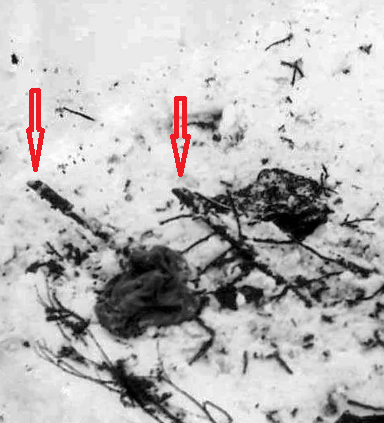
This is done with one oblique blow, which is completely impossible for a penknife or Finnish knife. And the hikers' axes, they had three of them: two large and one small, as well as a saw, - all remained in the tent and there they were found by the searchers. And there were no axes and saw neither near the flooring, nor near the bodies.
At the same time, the flooring was arranged in such a place that it was more convenient to get to the water water in the stream. This is in the event that there was a temporary camp site or bivouac nearby.
By the way, one of the two puttees was found on this same flooring. And if we take into account that the first puttee was found two months earlier in the tent left by the Dyatlov group, then the conclusion is that at the place of the death of the hikers there was someone else who cut down a dozen cedars and one birch, built a flooring in the ravine using them and left army puttees in the process.
The places where the puttees were found leave no doubt that the person who left them was not there before or after, but at the time of death of the hikers.
It should be noted that a spoon and an empty ebonite sheath were found in the snow near the flooring. Who did they belong to? Members of the Dyatlov group are unlikely, although not excluded. Members of the search party? It is also possible, although unlikely. Or maybe these are the things of those who built the flooring and then used it before the hikers arrived? Why did the investigation not begin to establish the identity of the spoon and sheath? Do you know? Me neither.
We will not stick to triviality and will leave all these little things like spoons, sheaths, and puttees for those who like to "catch fleas". We will give an assessment only to the den.
The den at the creek is evidence proving the fact of the presence of strangers at the place of the death of the hikers. Precisely - strangers. In the future, I will call them strangers. For brevity and completeness of understanding the picture of what is happening.
– 10 –
A few words should be said about the damage to the tent. It is believed that they were caused by the students trying to leave the tent in this manner. Allegedly their fear and desire to flee were so great that they forgot about everything, cut the tent in panic and, as if scalded, who was in what, jumped into the frosty and windy darkness to their own demise.
However, it is hardly possible to agree with such an interpretation of those events. The details of the situation, and their analysis, raise serious and reasonable doubts about the traditional interpretation of this fact.
This is Case files 388 back.
This is what we really have.
The fact is that there are a lot of cuts on the tent, there are at least 19 on this side.
For an emergency evacuation, one or two cuts of sufficient size would be enough. But on the tent, it can be clearly seen in the photo, the dimensions of most of the cuts eloquently indicate that they were not made at all in order to evacuate as quickly as possible, they are too small and there are too many of them, but for a different purpose, for example, to render the tent unusable after the hikers were simply driven out into the cold using threats and force.
Looking at this frenzied vandalism, you get the feeling that someone furiously poked a knife into the tarp with anger and it is unlikely that the students did it - the tent is damaged all over the surface, and if you consider that there were nine people inside, move along it with a knife to poke here and there and here and here, it would be simply unrealistic.
Let's not forget that there was no need to cut and tear the tent in order to go outside, since the entrance to it was open at that time and remained open (Case files 34).
There are recollections of one of the searchers, Sharavin, who recalled in his 2007 interview that he and his comrade with an ice pick chopped down the entire tent, trying to get inside in this way. According to Sharavin, there was an ice ax at the open entrance to the tent. They grabbed it and cut down the roof of the tent, which had only three large cuts before.
We will not believe Sharavin and regard his memoirs as invented retroactively on our own initiative or on a tip from the outside.
Why don't we believe it? Simply because there was no ice ax in the Dyatlov group. There is no ice ax in the inventory of the group's property available in the criminal case. The ice ax also does not appear in the protocols of inspections of the place where the tent was found, nor of the items inside. Sharavin himself has not been interrogated in the case, and his 2007 story can be safely assessed as a consequence of senile insanity.
How else to assess Sharavin's recollection about chopping down the tent with an ice pick to get inside? What prevented him from entering the tent through the open entrance or through the cuts that, according to Sharavin, the students cut in the tent?
For the sake of fairness, we note that witness Lebedev told about Sharavin and the ice ax found near the tent.
But they did not bother to interrogate Sharavin himself.
In such a situation, I can’t believe the prosecutor, who "marginalized" the dates of the initiation of the criminal case. In the same way, I cannot believe the testimony of Lebedev as a hearsay. And in what way is he better than the prosecutor?
What are you saying! These are not strangers! This is Sharavin! To hide the strangers, let's substitute Sharavin. And so that Sharavin "does not soar", Lebedev will tell about him in the third person. Lebedev is not an enemy, he is a Soviet man and a loyal Leninist. Member of the Komsomol, student. He understands the party's policy and will play ball.
Therefore, let Lebedev be heard by those who are convinced that the criminal case on the death of the hikers was initiated on February 26, and not on the 6. Let Tempalov, Ivanov, Klinov trust him. Let Prosecutor Kuryakov trust Lebedev with his "avalanche" doctrine. Just think, after the avalanche, an ice ax remained in the snow near the tent!!! Kuryakov! Can you hear me?
Yes, let them believe Lebedev. But not me ...
And another nuance. The file mentions a cut ski pole that served as a skate prop and was found in a tent by the first responders.
Here is the protocol of the interrogation of the witness V.D. Brusnitsyn from May 15, 1959 (Case files 362-369): "The tent is set on the slope of height 1079. Entrance to the south. The steepness of the slope in this area approx. 20-25°. Depth of snow up to 1.5 meters. A shallow pit is dug for the horizontal installation of the tent. Under the tent were laid 8 pairs of skis with their fasteners facing down. Thanks to the dense snow cover, the tent was installed very firmly... Buckets, stove, ax, saw were lying at the entrance to the right... On top of all things lay a ski pole cut into several pieces, on which, apparently, the northern end of the tent was stretched. Render a ski pole unusable, especially when the group didn't have a spare, is possible only under special circumstances..."
From V.A. Lebedev's testimony (Case files 315 back): "In the tent we found a ski pole from which the upper end was cut off along a neat end cut and another cut was made. This suggests that apparently someone stayed in the tent much later than others, maybe for a day. Because no one will cut a pole, that may still be useful, because there is nothing else to do."
One of the poles of the tent could be removed and cut by a person who remained inside after the hikers left. If the students were in a hurry to escape, it is clear that they would not cut any poles, because it takes time, which, as the investigation considered, they didn’t have.
A cut ski pole, a damaged tent (it doesn't matter if it was cut, torn or chopped down) - it may happen that someone unknown, ruthless and unforgiving, firmly decided that the hike would end right here, on the slope of 1079. And then those who covered this "someone" restricted the access to the area of the Dyatlov pass as a precaution and falsified the criminal case.
It was not the students who damaged their tent. These are the same strangers. This is their handiwork and another, second, piece of evidence that gives away their presence at the pass.
– 11 –
§7 If he hits me then he loves me
Although a comparative study has not been conducted, I fully admit that most of the damage to the tent was left by an ice ax. The ice ax really does appear in the case and is indicated in the inventory of the items (Case files 17). But I will never believe that Sharavin "riddled" the tent with an ice ax, trying to get inside in such an inexplicable and barbaric way.
The testimony of witness Lebedev about Sharavin and the ice ax is a hearsay and was NEITHER verified NOR confirmed during the investigation. Without interrogating Sharavin, Lebedev's testimony cannot be considered sufficient, and for some reason Sharvin was not interrogated during the investigation.
It seems as with the help of this information, the prosecutors did not investigate the crime, but, on the contrary, tried to hide it.
And even then, after all, in addition to the tent, the wounds remained on the bodies of the dead, on all of them, and Sharavin certainly has nothing to do with these injuries.
The theory of the Dyatlov group meeting with strangers and the conflict that occurred between them is confirmed by the presence of injuries on the bodies, characteristic of beatings and active self-defense. These injuries are present on all bodies and caused pre-mortem, that is, received during the time when the hikers were still alive.
For example, Slobodin had "in the middle part of the forehead, small abrasions of a brown-red color of parchment density, slightly depressed. Above them two scratches of a linear shape under a dry brown crust up to 1.5cm long. In the area of abrasions and scratches, hemorrhage was noted. on the right, a brown-red abrasion measuring 1x0.5cm. From the nasal openings there are traces of clotted blood. In the area of the metacarpophalangeal joints of the hands, there are sedimentation of the protruding parts of soft tissues in areas of 8x1.5cm, covered with a dry parchment density crust below the skin level."
The metacarpophalangeal joints of the hands are the knuckles usually hurt in a fight when clenching the hand into a fist.
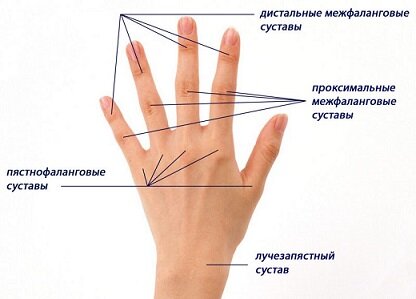
In addition to numerous abrasions and wounds on the arms and legs, Doroshenko's "upper lip is edematous, in the area of the red border of the upper lip there are red hemorrhages 1.5x2 cm in size".
Krivonischenko: "in the middle part of the forehead there is a rounded area of sedimentation measuring 0.3x0.3 cm of brown-red color of parchment density. In the left temporal region there are two abrasions measuring 1.2x0.3 cm and 1x0.2 cm. Along the entire diameter of the rear of the left hand there is a scalped wound with exfoliated epidermis 8x2 cm in size. In the right temporal and occipital region diffuse hemorrhage with impregnation of the right temporal muscle."
Dyatlov: "in the area of the left superciliary arch there is an abrasion, in the area of both cheekbones there are abrasions under a dry crust measuring 3x0.5x1 cm, 3x0.5 cm In the area of the metacarpophalangeal joints and interphalangeal joints, soft tissues of a lilac-colored parchment density, covered with dry caked crusts with hemorrhage into the underlying tissues".
Kolmogorova has abrasions on her face, abrasions on the metacarpophalangeal phalanges of both hands. In the lumbar region of the right lateral surface of the body, the right half of the abdomen, a bright red skin in the form of a stripe measuring 29x6 cm".
This is not all and not for everyone, taken from the conclusions of forensic medical examinations selectively, not for the sake of completeness, but rather for clarity.
For example, behind the right ear, Kolevatov had a "wound of an indefinite shape measuring 3x1.5x0.5 cm, penetrating to the mastoid process."
– 12 –
In addition, Thibeaux-Brignolle could have received a blow to the temple with a hard blunt object with a limited surface - he had a depressed fracture of the right temporal parietal bone in a 9x7 cm area with a defect in bone tissue and temporal bone measuring 3x3.5x2 cm.In the cranial fossa there is a multifragmented fracture of the right temporal bone with divergence and transition of the bone crack into the anterior cranial fossa to the right supraorbital region of the frontal bone and a 17 cm long crack in the base of the skull."
No, of course, it can be assumed that such a fracture can be obtained by falling and hitting his head on the stones. But in his case Thibeaux-Brignolle had to take himself by the legs and pound his own head on these very stones with a fury.
When a person stumbles and falls, the resulting weakness, lost consciousness, etc., are called inertial traumas. And such a fracture that Nikolay had can be obtained only when falling with acceleration, and very strong momentum, or with a direct impact with something very heavy and massive. This is evidenced by the fracture of the cranial vault in particular, and the complex combined nature of the fracture in general.
For those who doubt that Thibeaux-Brignolle was hit hard, I will quote a fragment of the forensic examination of the corpse of Thibeaux-Brignolle: "A woolen, knitted, green sports cap is dressed and tightly tied on his head... A khaki-colored canvas fur helmet with a zipper, the helmet is tightened with a drawstring."
As you can see, Nikolay's head was well protected from falls. With inertial falls from one's own height in a woolen cap and a fur helmet, such skull fractures cannot be obtained, no matter how hard you try.
And on the corpses of Dubinina and Zolotaryov there were multiple intravital rib fractures.

It is known that Dubinina had fractures of the 2, 3, 4 and 5 ribs on the right along the mid-axillary line, fractures of the 2, 3, 4 and 5 ribs on the right along the midclavicular line and fractures of the 2, 3, 4, 5, 6 and 7 ribs on the left along the midclavicular line lines, and Zolotaryov had fractures of 2, 3, 4, 5 and 6 ribs on the right along the peri-chest line and fractures of 2, 3, 4, 5 and 6 ribs on the right along the mid-axillary line.
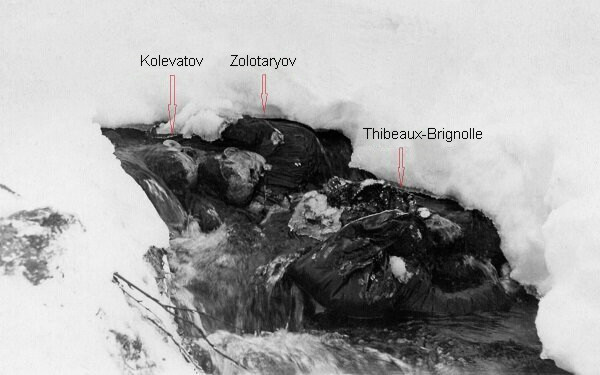
Such damage could not have been formed when falling on stones, but the wave could have been received as a result of impact on the horizontally lying bodies of heavy massive objects with an unlimited traumatic surface, for example, when hit by the wheels of a truck (in such cases, they usually say: "the roller has run over"). It is this extensive compressive effect that explains the nature of the fractures that Dubinina and Zolotaryov had in the absence of any external bodily injuries in their projection.
So, almost all the victims have injuries. Thibeaux-Brignolle was hit in the head with a strong blow, the chests of Dubinina and Zolotaryov were crushed... but what does the glorious criminal prosecutor Ivanov write in the decision to close the case?
Here's what. Dismissing the case, Ivanov wrote (I quote) "given the absence of external injuries and signs of struggle on the corpses."
Like this. Briefly and clearly. But we are not to badmouth the prosecutor. He's a good fellow, a real pro. He set the trap that, sixty years later, his colleagues - prosecutors of the 21st century - fell into.
Let them.
For me, the injuries of the dead hikers are another evidence of the presence of strangers. The evidence is weighty, serious, such that you cannot brush it off turn away. It was the strangers who beat the Dyatlov group. And they were not only beaten.
The topic of bodily harm will help us answer one strange question that still remains without an intelligible answer. The answer, which, in turn, may turn out to be the key to unraveling the tragedy that took place in the distant past at the Dyatlov Pass.
What if the bodies of Dubinina, Zolotaryov, Thibeaux-Brignolle and Kolevatov were not accidentally found in the ravine? What if strangers, using violence, first brought them into an unconscious state, and then simply dumped the unconscious bodies into the stream, considering them dead (it is quite possible that at least three of them were so). The reason is straightforward. Here, the thickness of the snow cover is much greater and the bodies hidden in the riverbed will not be found immediately, if at all...
– 13 –
§8 Snowmobiles
Probably, the time has come to tell you how did the three hikers sustained the serious bodily injuries, dangerous to their health and life.
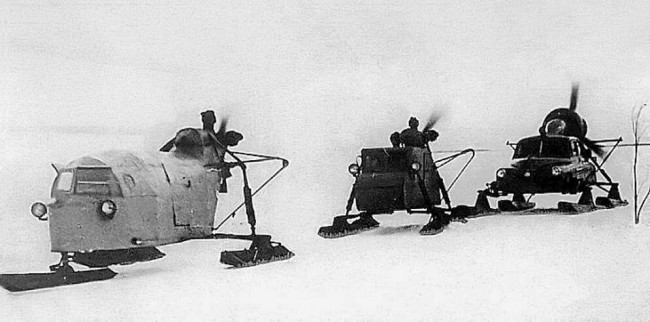
I will not torment the reader any longer. I think that Dubinina and Zolotaryov were run over by a snowmobile. Thibeaux-Brignolle head injury, the wound on Kolevatov's head, and the linear abrasion on Kolmogorova's side and lower back could also have been caused by a snowmobile.
This is what Dubinina's rib fractures looked like.
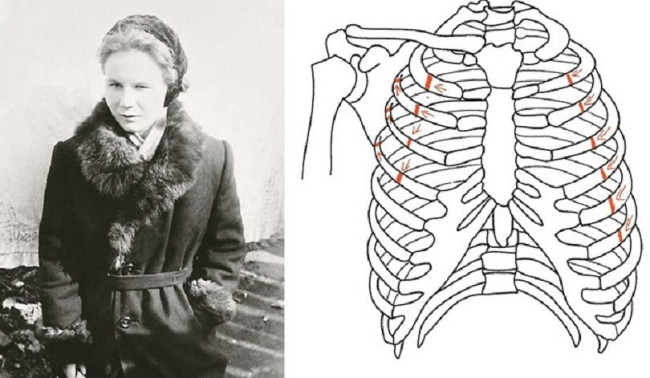
This is how they look from Zolotaryov's autopsy report.

And this is how rib fractures look in case of an automobile injury when a car or other vehicle runs over a lying body.
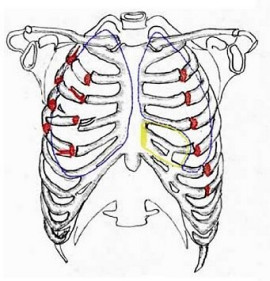
Snowmobiles can also cause similar damage when run over a person.
But what kind of animal is this - a snowmobile? Where did this idea come from?
I just remembered the wonderful Soviet film "Cruelty" with Georgiy Yumatov and Boris Andreev in the lead roles, which clearly shows how the police chief (performed by Nikolay Kryuchkov) inspected the territory under his jurisdiction, driving around the vast taiga edge on... snowmobiles.
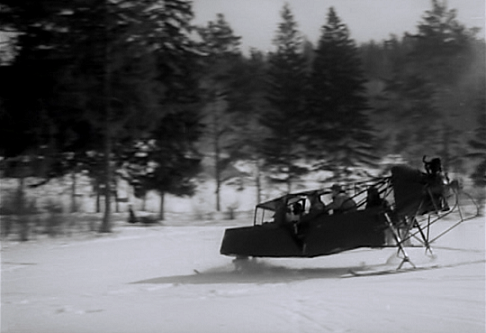
Frame from the movie "Cruelty"
Snowmobile... why not? The site of the tragedy at the height of 1079 seems to be specially adapted for such transport. And the entire surrounding area, and the whole district. Where snowy off-road and rough terrain - better transport than snowmobiles - you will not find.
What did we have about snowmobiles in the Soviet transport arsenal of that time??
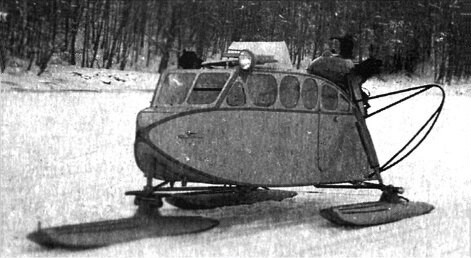
OSGA (NKL-6
These are, first of all, three running models: the OSGA or NKL-6 produced since the pre-war times, the later NKL-16 and Sever-2 based on the Pobeda car body.
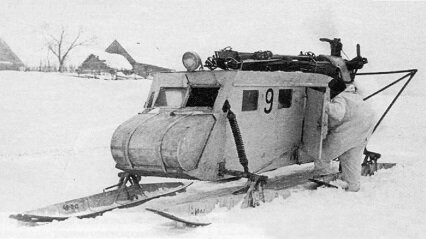
NKL-16
There were other modifications of the sled, for example, NKL-18 or KA-30, but these three are the main ones. All models are cargo and passenger with a weight of around two tons and, what is most important for us, equipped with powerful wide skis.
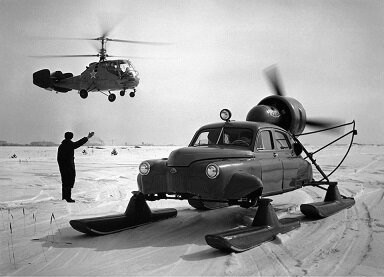
Sever-2
Oh, these skis! They are not afraid of ice, snow, or rocky slope, or streams, or woodlands! And if a person falls under them, God forbid, of course, the result will be the same as that of unfortunate hikers: multiple fractures of the ribs along the sternum, axillary or scapular lines (depending on how the person will lie - on his back, face down or on his side). You can be sure that on February 1, 1959, nothing fell from the sky to height 1079, no flying saucers, no rocket engines, no comets with meteors. All the evil was done here down, on earth.
– 14 –
§9 Smoke and mirrors
During the investigation, the forensic expert B.A. Vozrozhdenniy was questioned, who performed the autopsy of the bodies of the dead.
His testimony by itself can mislead the reader and therefore require a separate commentary.
Vozrozhdenniy, of course, said nothing about the snowmobile. But the expert told about something else.
He, in particular, said: "I think the character of the injuries on Dubinina and Zolotaryov – a multiple fracture of the ribs – on Dubinina were bilateral and symmetrical, and on Zolotaryov were one-sided. Both had hemorrhaging into the cardiac muscle with hemorrhaging into the pleural cavity, which is evidence of them being alive [when injured] and is the result of the action of a large force, similar to the example used for Thibeaux-Brignolle. These injuries, especially appearing in such a way without any damage to the soft tissue of the chest, are very similar to the type of trauma that results from the shock wave of a bomb. (Case files 382)

Such testimony from an expert requires some explanation, since in fact there was no blast wave in the case of Dubinina and Zolotaryov, and Vozrozhdenniy, a professional forensic physician, could not have been unaware of this.
The fact is that a characteristic and obligatory consequence of the impact of the blast wave on the human body is the contusion of internal organs. This rule is all the more imperative for deceased hikers if one takes into account the fractured ribs, since damage to bones requires a much more powerful force than to damage internal organs.
In other words, if the bones are broken as a result of the concussion, then the internal organs must bear traces of the concussion without fail.
But in our case, neither Dubinina nor Zolotaryov has anything like this.
What is the mechanism of damage to human internal organs during contusion?
"Typical blast damage to the human body includes ruptured eardrums with consequent hearing loss and vestibular disorders. Damage to the chest organs occurs due to their compression between the spinal column, the moving inward chest and the rising diaphragm due to the ramming action of the abdominal organs, which were affected by the shock wave". (from Wikipedia)
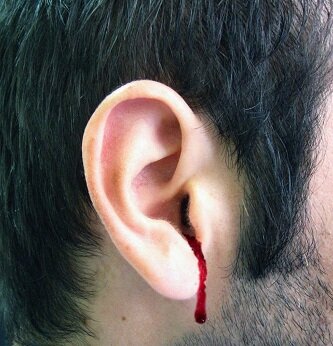
If hikers had a severe concussion, they would have ruptured eardrums, brain contusions, ruptured internal organs and blood vessels.
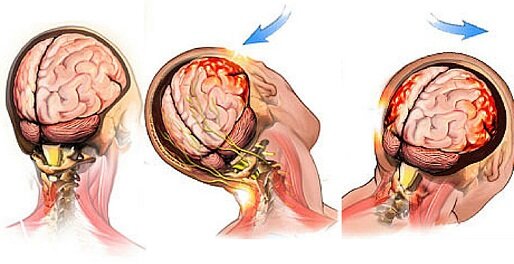
But there is nothing like that. And damage to the heart muscle in Dubinina and hemorrhages in the pleural cavity in Zolotaryov are caused not by contusion, but by the traumatic effect of bone fragments due to rib fracture.
In addition, if the hikers were hit by a blast wave, then everyone would have had typical contusions, and not only Dubinina and Zolotaryov, since the whole group kept together from the moment they left the tent until they made a fire near a cedar at the edge of the forest. This circumstance is confirmed by the presence on the clothes of Dubinina (pants) and Kolevatov (jacket sleeve) damage with burned edges. This means that they, along with everyone else, were at the cedar at the time of making the fire and for some time tried to keep warm on it.
And it also means that all the hikers got to the cedar unharmed, and the injuries to Dubinina, Zolotaryov and Thibeaux-Brignolle were received later. At the same time when Kolevatov received a blow to the head.
Consequently, the reason for the hikers to leave the tent was not an explosion at all, but something else. Or someone else.
In the event of an explosion, everyone would get a shell shock. But only two of them had bodily injuries, which Vozrozhdenniy supposedly believed to be an explosive concussion, and, as we just found out, it was not a concussion at all.
– 15 –
§10 Breaking the veil of years
As I said, most likely the hikers were crippled by the snowmobile.
The beginning of the conflict was laid at the tent. What exactly caused it, I cannot say. Alcohol, women, careless words - all of this, like many other things, could have taken place. After the hikers left the tent and in an organized way got to the edge of the forest, the strangers allowed the Dyatlov gorup to make a fire and did not interfere with them for some time, although they did not help them either.
But then the conflict continued, escalated into a fight, as a result of which two hikers found themselves under the skis of a snowmobile. Thibeaux-Brignolle and Kolevatov, most likely, were hit by a snowmobile, as a result of which Thibault received skull fractures, and Kolevatov received a strong blow to the head, which permanently deprived him of consciousness. The linear abrasion on the lower back and on the side of Kolmogorova may have also occurred from contact with the snowmobile.
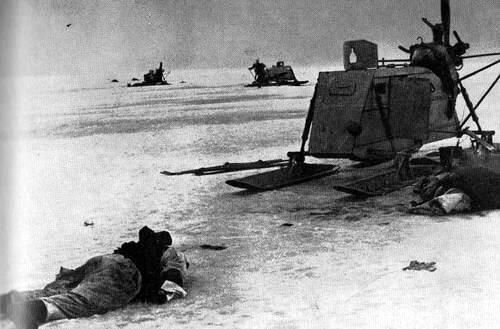
How it all happened - I cannot say unequivocally. Perhaps, the hikers, exhausted from beatings and frost, were chased with snowmobiles like hares across open areas in the headlights. Perhaps, after the beating, they simply pushed them into the snow and rolled them on a sled from above... I don't know.
But when the strangers, as they sober up, began to realize that four out of nine did not show signs of life, they threw their bodies into a stream not far from their bivouac or camp and hastily retreated, leaving the rest, already dying from the cold, to their fate.
The behavior of strangers is understandable. They did not plan the crime in advance and did not intended to kill anyone. The encounter with the hikers turned out to be accidental, events developed spontaneously and the reaction to what was happening was in the spur of the moment.
To show who is in charge, to hide the dead, and to hide themselves from the living - this perhaps could be the behavioral motivation of strangers. There is nothing strange or illogical here. Everything is quite clear and understandable.
The strangers were not professional criminals and they did not plan their violent act in advance. At first, they were under the influence of alcohol in a state when "the sea is knee-deep" and "I can get away with anything". The feeling of superiority over the hikers led to the harshness with which the local "masters of life" acted, but then the false heroism and victory were replaced by fear for what they had done, confusion and helplessness. The prospect of inevitable responsibility caused a natural desire to quickly break out of the trap into which strangers themselves had driven themselves. "Scram!" - this is the only correct way out!
The child in such a situation, in order to escape from his own fear, hides under the blanket. The strangers did about the same: they fled from the scene of the crime and fell to their knees in front of their "masters", hoping for their mercy and protection.
After the strangers retreated, Dyatlov, most likely, decided to return to the tent. Every chance to survive is there! Warm clothes, shoes, food, documents are in the tent.
Georgiy Krivonischenko and Yuri Doroshenko by this moment were already so frozen and exhausted that they could not move on their own and they had to be left by the fire.
Three went back to the tent, but they were doomed. The first to fall was Igor Dyatlov, followed by Rustem Slobodin. Zina Kolmogorova made it closest to the tent. She had 850 meters left when she collapsed...
– 16 –
§10 Get out of the trap!
... By not accepting the Russian prosecutor's office considering an avalanche to be the cause of the death of the Dyatlov group.
Actually, at first, the investigators "played up" another version: they say, the whole point is in a very strong wind. One of the hikers came out of the tent, but he was blown away by the wind. The rest rushed to help, but they were carried along the slope with such force that they simply did not have the physical strength to return back.
This version was considered only until the last four bodies were found in the ravine near the spruce flooring. The injuries on the bodies clearly did not fit into the version of the "strong wind", which is why the investigation, terminating the proceedings, had to confine itself to a vague conclusion about the elemental force of a natural origin.
But today the prosecutors got courage and came up with a "snow avalanche". Namely, they came up with it, because those who worked at the scene and saw the situation with their own eyes did not have a single thought about an avalanche. After all, the tent and things in the tent were all found in their places...
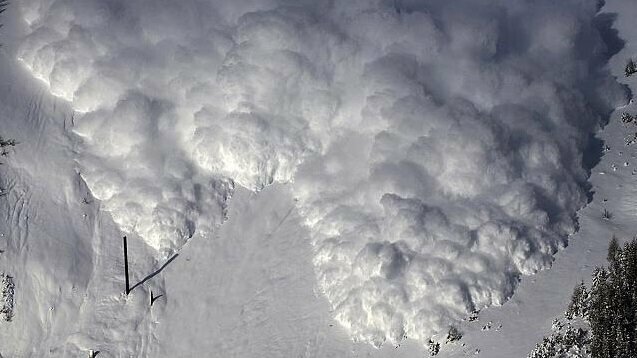
Let's leave the new version on the conscience of the prosecutors who voiced it, and turn to the case files again.
Case files 2 is a protocol of the place of detection of the campsite of the Dyatlov group (so in the document, it is printed on a regular sheet of paper - the word "inspection" is probably missing) dated February 28, 1959, which says: "The campsite is a snow-leveled area with 8 pairs of skis at the bottom. The tent is stretched out on ski poles, fixed with ropes, 9 backpacks with various personal belongings of the group members were laid down at the bottom of the tent, quilted jackets, storm jackets were put on top, 9 pairs of felt boots were found where the heads must have been, men's trousers were also found, and three pairs of felt boots..." etc. Anyone can read this document to the end, it is available on the Internet and it follows from it that the original location of the tent and the order of items inside are not disturbed.
Or V.D. Brusnitsyn statement from May 15, 1959 (Case files 362-369): "The tent is set on the slope of height 1079. Entrance to the south. The steepness of the slope in this area approx. 20-25°. Depth of snow up to 1.5 meters. A shallow pit is dug for the horizontal installation of the tent. Under the tent were laid 8 pairs of skis with their fasteners facing down. Thanks to the dense snow cover, the tent was installed very firmly... Buckets, stove, ax, saw were lying at the entrance to the right... On top of all things lay a ski pole cut into several pieces, on which, apparently, the northern end of the tent was stretched."
The tent remained standing in the place where it was set, the order of things in it remained the same as it was when the hikers left it. Dyatlov's flashlight remained on the top, Prosecutor Tempalov saw and photographed footprints in the snow going away from the tent, and witness Lebedev even told about an ice ax supposedly sticking out of the snow at the entrance to the tent.
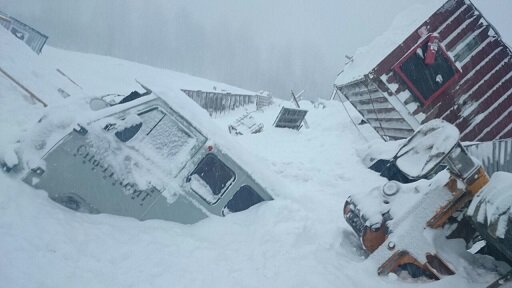
Well, where is the avalanche, good gentlemen? Where is the natural element that sweeps away and destroys everything in its path?
We assumed that on height 1079, the Dyatlov group had a conflict with those they met there. We also assumed that as the conflict developed, the students were kicked out of the tent in the cold, the tent was rendered unusable, the students were beaten, and then they were chased in the headlights of a snowmobile along a mountain slope and the hollow, and at least two of them were run over with sled skis.
What kind of monsters were they? Judging by how closely the military took care of the investigation, the Ministry of Defense was involved.
Perhaps the the Dyatlov group came across a patrol or a temporary observation post or cordon in connection with the next exercises or tests in the Ivdel region. There were more than enough forbidden zones at that time. Perhaps someone was carrying mail, groceries or something else, maybe someone, like in the movie, was making an inspection tour, or maybe it was the weekend hunting trip of some higher authorities - February 1, 1959, falls on a Sunday.
– 17 –
At that time, all these circumstances could be easily and quickly established, since the fleet of snowmobiles was not large, a dozen, maybe a dozen. All of them were registered with the state and belonged to legal entities, which greatly facilitated the search. Party and Soviet bodies, departments of internal affairs and the KGB, post office, consumer cooperation, ambulance... What else is there? The military, the commandant's office, the administration of correctional camps...
Check the waybills, exit permits, fuel consumption coupons - and the picture would have cleared up.
Interrogate the snowmobile drivers, inspect the logs of their departure from garages outside military units, mailboxes, secure facilities and civilian enterprises. Ask the military for a certificate of training, test or other special events in the area during the period, say, from January 30 to February 2, inspect the most suspicious snowmobiles for damage, fresh dents, scratches, abrasions, traces of blood, etc. - and within a few days an exhaustive picture would unfold before you of whom to hold responsible. Considering that everyone is honest.
Prosecutors and investigators were obliged to put forward such a version and carefully check along with others, natural and man-made, - to do this required the completeness, comprehensiveness and objectivity of the investigation.
In fact, everything was much simpler, because already in early February the authorities had information about what exactly happened and who was to blame. But they, apparently, decided to hide the perpetrators.
For this reason, prosecutors defiantly ignored the human factor and from the very beginning focused on purely natural phenomena, giving preference first to a strong wind, later to a faceless elemental force, and now to an avalanche.
And therefore, reluctantly, we must admit that, be that as it may, but the true details of the tragedy at the Dyatlov pass on the night of February 2, 1959, we will most likely never know...
You can live in a trap. Even if you cannot move, in pain, hunger and thirst - yes, you can live in a trap. And if you haven't eaten anything sweeter than a turnip, even a trap may seem like a palace. And even if the air in the trap is saturated with lies, well, they can breathe them deeply, considering the suffocating stench an elixir of life.
Just a bad tree won't give birth to good fruit. Over time, lies grow like a weed, become taller, thicker, more tightly entwining hearts and souls. Blissful in a trap, you can easily write that during one hiking trip in the mountains of the northern Urals, people died due to the negligence of the leader. You can casually question the name of a good person and denigrate him with one single purpose - to shield the scoundrel, smeared from head to foot with someone else's blood. Innocent blood.
Sitting in the trap, he gave to one the shame of the whole world and a common grave, and to the other - compliance with the position held and enrollment in the reserve for promotion.
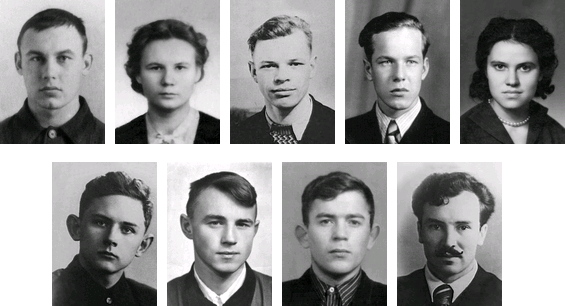
I cannot open this trap and release the exhausted beast to freedom by myself. However, it was worth trying to do this if only to live the rest of my life in harmony with my own conscience. In an effort to put an end to the regal cynicism and incessant lies around the death of the hikers at the height 1079 in 1959, I dared to carry out this little investigation of mine, which, with a sense of accomplishment, I submit to the strict judgment of the reader and dedicate to the good name of Igor Dyatlov and the blessed memory of those who in that terrible night died at the pass with him.
You can discuss this topic on Dyatlov Pass Forum.

